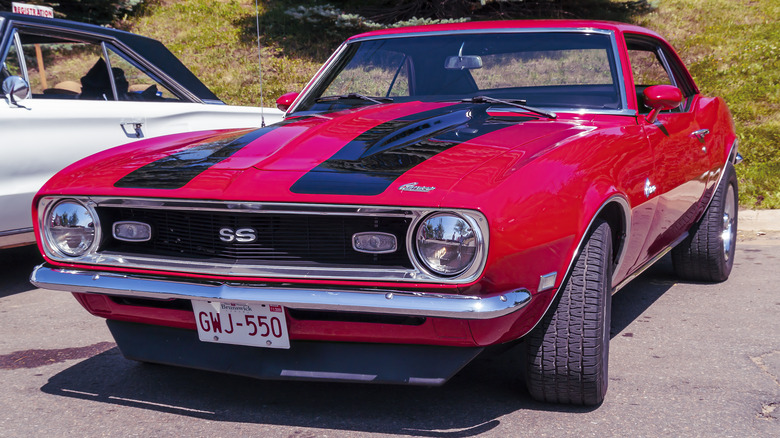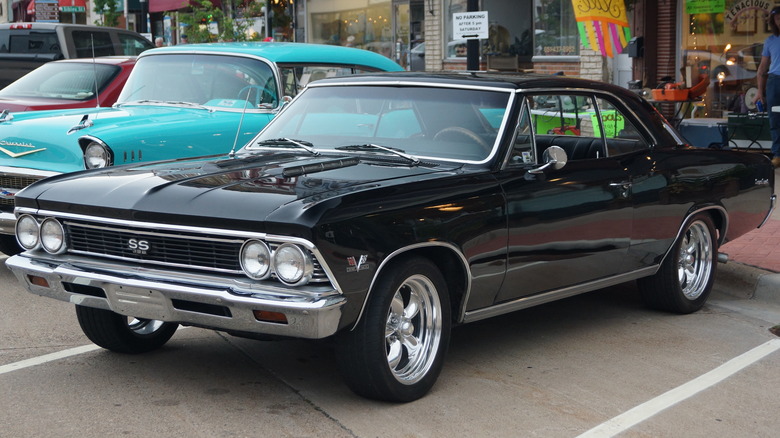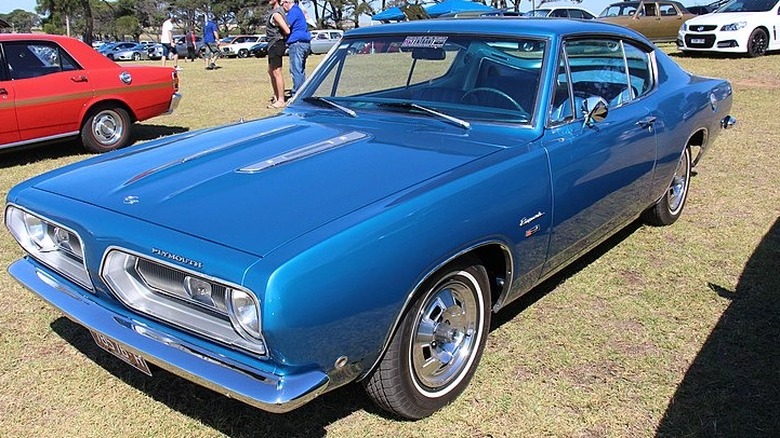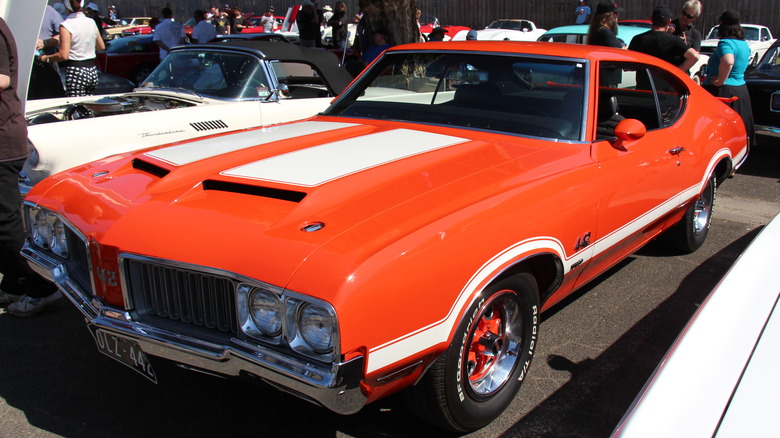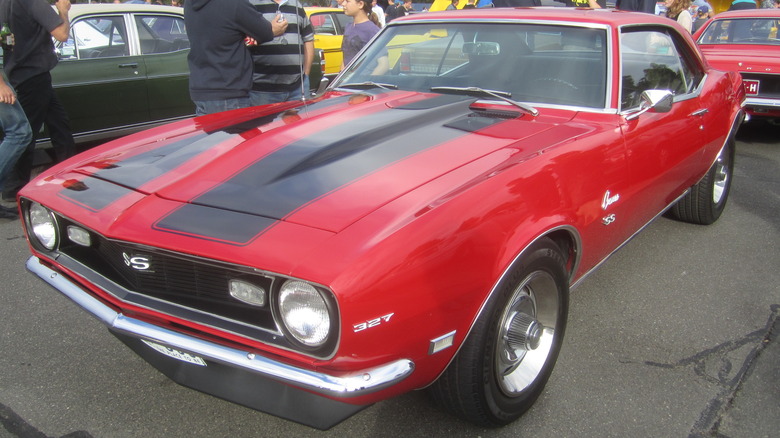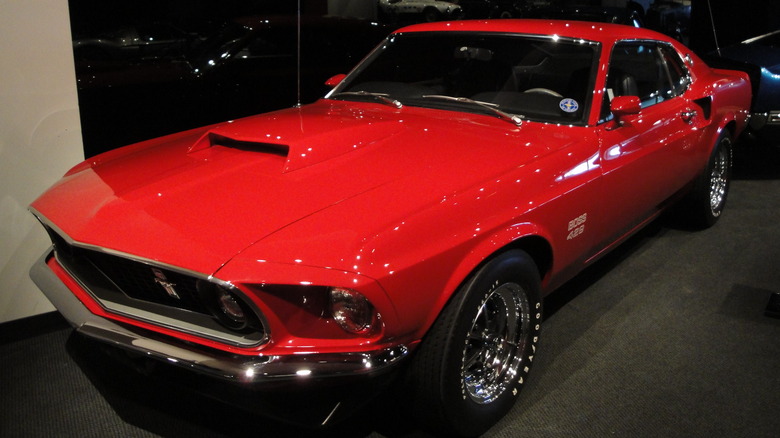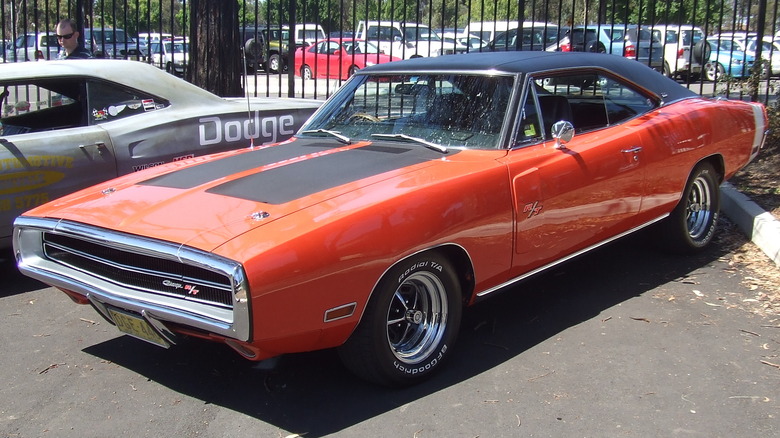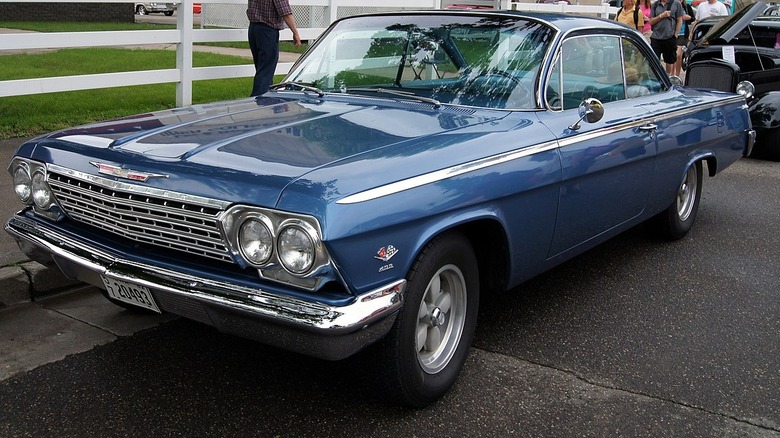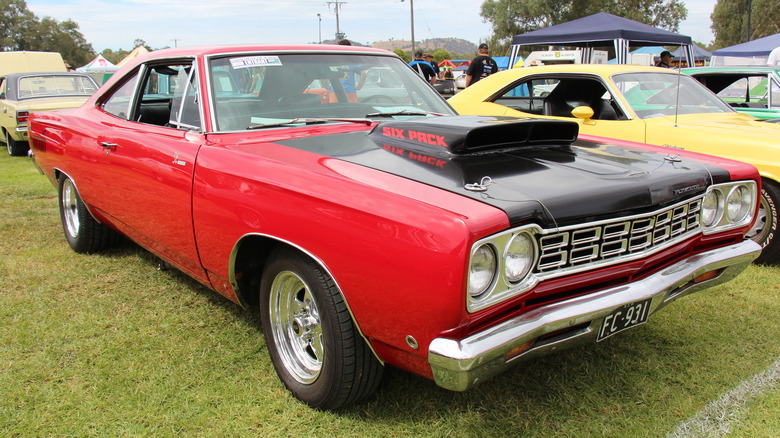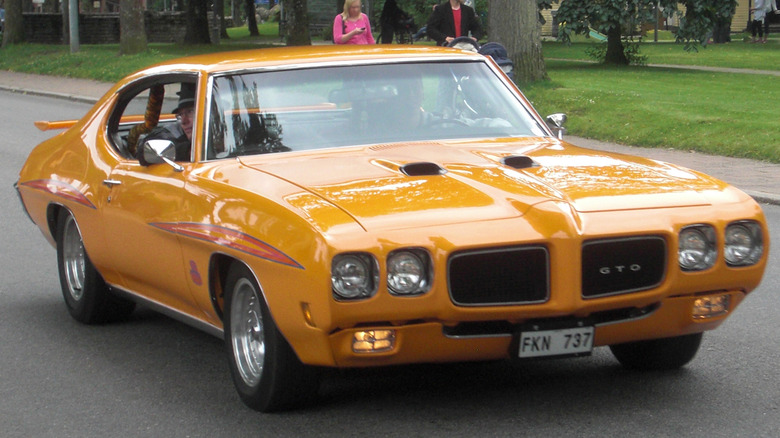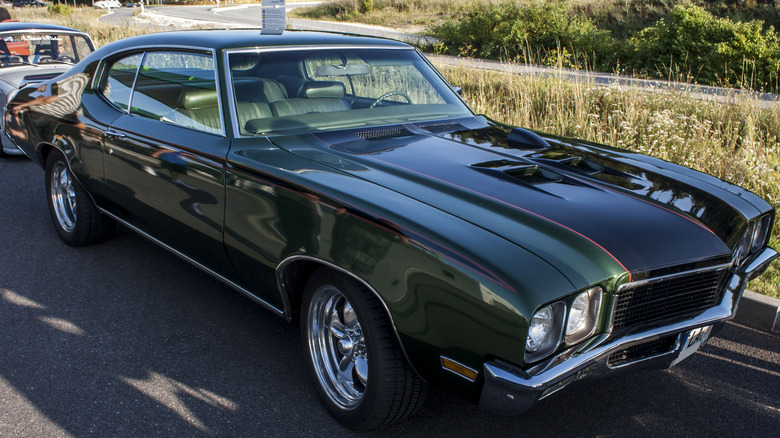10 Of The Coolest Classic Muscle Cars With Big Block Engines
The American muscle car may be one of the most beloved vehicle genres ever created. Some say muscle cars arrived as early as the 1950s, while others place their conception firmly in the 1960s. Whatever your opinion, there is no debate that the mid-1960s to early 1970s represented the golden era of muscle cars.
Manufacturers slammed ever-more powerful engines into vehicles accessible to the masses and delivered performance on levels previously undreamed of. Meanwhile, the design elevated them from the status of future classics to American icons. Today, though, muscle cars aren't just aesthetically pleasing — they represent a bygone generation of incredible styling that elevates these cars from future classics to the automotive icons of an age.
In the halcyon days before regulations dictated emission standards, displacement was the most significant arbiter of a car's power. The bigger the engine, the badder the ride, and big blocks were king. Large engine blocks allow for a wider bore and a deeper stroke than smaller blocks, meaning more bang-bang in the combustion chamber. However, in the decades since the heyday of the muscle car, displacement has become less of a thing, and the shift to EVs means it won't be again anytime soon. To honor these beasts of yesteryear, we've crafted a list of the coolest big-block muscle cars ever to hit the pavement.
1966 Chevelle SS 396
You can't spell Chevelle with Chevy. Well, you can – barely – but that doesn't mean the Chevrolet Chevelle is anything less than a General Motors legend. Amongst the most famous of the bygone era of muscle cars, the Chevelle captured the hearts of muscle car fans at its inception in 1964. Considered mid-sized by the day's standards, the Chevelle competed against similar class offerings from most major manufacturers, and it outsold them all.
Chevrolet's 1966 Chevelle SS 396 might not have the largest displacement of the big-block beasts, but it represented a leap forward. The L78, the first big block engine produced by Chevy, had only appeared on the scene a year prior, and it was earmarked only for the Corvette and the Chevelle. The 1966 Chevelle 396 put out north of 350 horsepower, but it wasn't just its power rating that gave the '66 Chevelle a worthy legacy. It also paved the way for the legendary Chevrolet big blocks of the future.
No-nonsense styling, clean lines, and a classic stance make the '66 Chevelle a treat to look at and, for the fortunate few, get behind the wheel. The market is wild for these cars, and scoring one may be a bank-buster, but for the fortunate few, their timeless looks make them one of the coolest cars to come out of the era. The clean lines and rumble power of the 1966 Chevelle have made it a fan favorite for decades.
[Featured image by Greg Gjerdingen via Wikimedia Commons | Cropped and scaled | CC BY 2.0 DEED]
1968 Plymouth Barracuda B029 Super Stock Hemi
Chrysler made the hemispherical engine famous with its muscle car offerings, and the 1968 Hemi Plymouth Barracuda B029 may represent the pinnacle of the hemi-craze. Based on the Valiant, Plymouth introduced the Barracuda in 1964 — just two weeks prior to the Mustang, which is often erroneously cited as the first pony car.
Though not as big-name as the Chevelles and Mustangs, the B029 Super Stock was the quickest-accelerating factory car of the muscle era. A redesign for 1967 ditched the bubble rear window and Valiant-inspired styling in favor of beautiful rear-quarter haunches that made the 'Cuda look forever crouched at a starting line. Not only did it look much meaner, but some genuinely insane things were happening in the engine bay.
Mopar engineers announced their intention to compete in the Super Stock competition. They had to make structural changes to the car to fit the massive 426 cubic-inch block under the hood. Of course, there are two ways to make a car faster: more power and less weight. The race 'Cuda got a lightweight hood and doors and disposed entirely of pesky afterthoughts like heaters, rear seats, sound insulation, and mirrors.
Plymouth built fewer than 70 of the 1968 B029 Super Stocks, so potential buyers must reach deep into their wallets to score one. When they do come up for sale, which is rarely, they don't often sell for fewer than six figures.
[Featured image by Greg Gjerdingen via Wikimedia Commons | Cropped and scaled | CC BY 2.0 DEED]
1970 Oldsmobile 442 W30
Oldsmobile helped push the car industry toward experimenting with ever more power. The 1949 Oldsmobile Rocket V8 innovated with overhead cams, pushing output to the 300-hundred-horse range in the 1950s. Fast forward a decade, and the Oldsmobile engineers had taken that mindset headfirst into the muscle car competition.
Unlike many cars on this list, the numbers in the title do not indicate displacement. The manufacturer pulled a fast one, instead naming the car for its original four-barrel carb, four-speed transmission, and dual exhaust setup. Look under the hood, and you'll see that the W30 442 packed 455 cubic inches, producing 365 horsepower.
Installed in a neat package reminiscent of the fastback-esque lines of the same year's Chevelle, there is no mistaking that the 442 is a full-fledged member of the muscle car community. The 1970 Oldsmobile 442 W30 takes its righteous place amongst the nobles of the big block craze and is now considered one of the best 442s of all time.
[Featured image by Sicnag via Wikimedia Commons | Cropped and scaled | CC BY 2.0 DEED]
1968 Chevrolet Camaro SS 396
The Plymouth Barracuda and Ford Mustang caught Chevrolet flat-footed with their introduction in 1964, but General Motors was quick to catch up. In 1966, Chevrolet introduced the vaunted Camaro. After a shakedown cruise, the 1968 model year roared in, packing a staunch 396 cubic inch big block. 1968 marks the mid-point for the first generation Camaro, as the following year's model marked a departure stylistically, with the 1969 model adding some cosmetic flair, including the distinct shark fins behind the doors. While gorgeous in its own right, it doesn't quite have the appeal of the 1968 model's simple lines.
The sweet spot '68 included newly federally-mandated side-marker lights, making it easy to identify against the '67 model. Everything about the '68 Camaro refined what Chevy had begun with the previous model. Gone were the triangular vent windows, replaced by what Chevrolet called Astro Ventilation, which introduced outside air into the cabin without wind noise.
Perhaps the most frustrating thing for modern gearheads (other than the fact that cars like this just aren't built anymore) is that for $300 — about $2,700 today — buyers could upgrade their SS package to score the 375 horsepower L78 396 engine. Chevrolet built around ten thousand SS Camaros in 1968, but survivors are rare, and the fan-favorite draws premium prices on the auction block.
[Featured image by Sicnag via Wikimedia Commons | Cropped and scaled | CC BY 2.0 DEED]
1969 Ford Mustang Boss 429
We're not going to split hairs over what constitutes a pony car. Technically speaking, pony cars tend to be lighter and more economical than heavier and larger muscle cars, but there is no doubt that the 1969 Boss Mustang 429 was as muscular as any car of the era, if not more so. One of the few cars of this era to enjoy continuous production from its inception to today, there can be no doubt that the Ford Mustang was and continues to be an absolute legend.
Arguably the meanest-looking car on this list, Ford developed their 429 motors to compete with Mopar's big-block engines, not to mention arch-rival Chevrolet's strong challenger in the Camaro, on both the race track and the streets. The Boss is a homologation car — one sold to the public to satisfy racing regulations — but built for the track. Fewer than 900 Boss 429s were ever built, meaning there is a very long list of people who would be interested in owning this extraordinarily rare vehicle. Nowhere is this more evident than on the auction block — in 2007, one of the first hand-built Boss 429s sold for $605,000!
The Boss 429 provided 375 horsepower and north of 400 lb-feet of torque cycled through a four-speed manual transmission. Together, they pushed the car, weighing in at about 3,500 pounds, to 60 miles per hour in a shade over five seconds — perhaps not mind-bending by modern performance standards, but certainly a benchmark for the age.
[Featured image by Greg Gjerdingen via Wikimedia Commons | Cropped and scaled | CC BY 2.0 DEED]
1970 Dodge Charger Hemi R/T
Some might say that the original "The Fast and the Furious" movie brought the Charger into the spotlight, but true fans had been fawning over the Mopar monster for decades before Vin Diesel aired the front wheels out on the silver screen.
Dodge wanted to in on the muscle car competition, arriving in 1966 with the inaugural Charger, which was based on their more family-oriented Coronet. By 1970, things were in full swing. The 1970 R/T 440 boasted more than 370 horsepower and a truly impressive 480 lb-ft of torque, giving Dodge a bona fide combatant in the muscle car wars. The Charger was so beastly that NASCAR eventually restricted, then banned, the R/T's cousin, the Charger Daytona, from competition. If that's not an argument in favor of this being one of the coolest big blocks ever built, there isn't one.
If you thought the Mustang Boss 429 was rare, consider that Dodge built a grand total of approximately 120 Hemi Charger R/T's in 1970. It's unusual to see one come up for sale these days, and it's not uncommon to see them fetch six figures or more.
[Featured image by Jeremy via Wikimedia Commons | Cropped and scaled | CC BY 2.0 DEED]
1962 Chevrolet Bel Air 409
Most car nuts who envision the Bel Air come up with the ultra-famous Tri-Fives of 1955, 1956, and 1957. However, it was the fifth generation of the Bel Air that saw the widespread availability of the legendary 409 big block engine. The result is the missing evolutionary link between the fading design ideals of the 1950s and the peeled rubber power of the muscle car.
The angular rear fenders hint at what would arrive a couple of years later in the debut Chevelle, but the distinctive bubble-top roofline was firmly entrenched in the 1950s. The result is a distinctive design wrapped around 360 horsepower and 410 lb-feet of torque, respectable numbers even for the muscle era that would arrive a few years later.
Chevrolet's 409 cubic-inch engine displayed the possibilities of big block power while representing freedom for an entire generation, as immortalized in the Beach Boys on their debut album "Surfin' Safari." The song paid homage to the engine rather than the Bel Air specifically, but the 1962 Bel Air 409 had plenty of giddy-up, not to mention the song and car both hit the street in 1962.
[Featured image by Greg Gjerdingen via Wikimedia Commons | Cropped and scaled | CC BY 2.0 DEED]
1972 Plymouth Roadrunner 440 6-Pack
The 1970 Clean Air Act marked the beginning of the end of the glory days of muscle cars as sweeping regulations authorized governments to create gasoline and emission standards for manufacturers. However, Plymouth wasn't quite finished. With its flowing, distinguished outline, the 1972 Roadrunner GTX 440 6-Pack is the newest and rarest car on this list.
This car is so rare that there were decades of doubt about whether it even existed. The problem was that the 440 cubic-inch motor outfitted with triple two-barrel carburetors did not meet the requirements of the Clean Air Act – which could put Chrysler in the hot seat with the EPA had it been publicized. While Plymouth produced over 7,500 440 Road Runners in 1972, only three came with the six-pack carb and an anachronistic electric sunroof.
There are several theories about how the car came to be and even more questions about how it reached the street. Still, one truth remains: it is the last gasp of an era on the downswing. The genuine '72 Roadrunner 440 6-Pack is so rare as to be virtually priceless. However, enthusiasts can still find Roadrunners to modify to be just like it — though they aren't exactly getting more affordable with age.
[Featured image by Sicnag via Wikimedia Commons | Cropped and scaled | CC BY 2.0 DEED]
1970 Pontiac Gran Turismo Omologato
Didn't know Pontiac built an Italian car? Don't stress; no conversation about the coolest muscle cars is complete without a mention of the Gran Turismo Omologato. Better known as the Goat, the Pontiac muscle car was named after a Ferrari, but that's where the similarities end.
Though Pontiac did not have the typical engine architecture delineating small and big blocks, we let the Pontiac Gran Turismo Omolgato slip onto our list based on its massive 455 cubic-inch engine and unquestionable place in the muscle car hall of fame. Pontiac upped their big block displacement to 455 inches in 1970 –- the high water mark of muscle car performance and production. The Gran Turismo Omologato was born as an option denoting a larger engine for the Pontiac Tempest. In 1964, it came into its own as a full-fledged model, and the rest was history.
The 455 cubic-inch big block in the 1970 GTO supplied 360 horsepower, which was middling for the muscle cars of the day, but its incredible torque rating of 500 lb-ft put this GTO on a new level. Shoehorned into a body that looked like a Trans Am crossed with a Chevelle, this big-block GTO represented the best of all worlds in the industry -– a reputation it has sustained.
[Featured image by Achird via Wikimedia Commons | Cropped and scaled | CC BY-SA 3.0 DEED]
1970 Buick Skylark GSX
The Skylark took on many forms during its impressive 46-year run, making it a litmus test for the spirit of whichever age you happen to examine. However, Buick was not immune to muscle, and the 1970 Skylark GSX represents their entry into the field. There's no doubt that the sharp lines of the Buick Skylark turn heads, but it's what's under the hood that sets the 1970 Buick Skylark GSX apart.
With a long hood and curving, fast-back inspired rear end, the '70 Skylark is both flowing and squat, even the uninitiated can tell it screams muscle. The GSX model represented Buick's best effort to beat the premium cars of other lines, including the Chevelle SS, GTO Judge, and 442 W30.
Though it did not fare well commercially, the GSX achieved one admirable distinction: it trumped all other challengers in the torque competition, providing 510 lb-feet of torque and outclassing even the gargantuan GTO of the same year. Interestingly, both cars had the same displacement of 455 cubic inches. Incredibly, that torque record held for decades, not being bested until the 2003 Dodge Viper unseated the champ.
[Featured image by Robotriot via Wikimedia Commons | Cropped and scaled | CC BY-SA 3.0 DEED]
